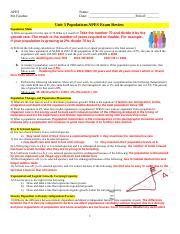The APES (Advanced Placement Environmental Science) exam is a three-hour and 15-minute multiple-choice and free-response exam that tests students on their knowledge of environmental science. Unit 3 of the exam covers populations and dynamics.

Key Topics
- Population ecology and its principles
- Population growth models (exponential and logistic)
- Population characteristics (density, distribution, and age structure)
- Factors affecting population growth (density dependence and independence)
- Carrying capacity, habitat, and niche
- Metapopulations and species diversity
Common Mistakes to Avoid
- Not understanding the difference between exponential and logistic growth.
- Confusing density-dependent and density-independent factors.
- Not being able to identify the carrying capacity of a population.
- Not understanding the concept of a metapopulation.
- Not being able to calculate population growth rates.
How to Prepare
To prepare for the APES Unit 3 exam, students should:
- Review the course syllabus and textbooks.
- Take practice tests and review the answers.
- Use online resources such as Khan Academy and AP Classroom.
- attend review sessions.
- forming study groups.
Why Populations Matter
Populations are the foundation of ecosystems. They provide food, shelter, and other resources for other organisms. Populations also play a role in regulating the climate and protecting water quality.
Benefits of Studying Populations
Studying populations can help us:
- Understand the factors that affect the growth and decline of populations.
- Predict how populations will respond to environmental changes.
- Develop strategies to protect threatened and endangered species.
- Manage natural resources sustainably.
Step-by-Step Approach to Population Studies
- Define the population you are studying.
- Identify the factors that affect the population’s growth and decline.
- Collect data on the population’s size, density, and distribution.
- Analyze the data to determine the population’s growth rate.
- Make predictions about the population’s future.
Applications of Population Ecology
Population ecology is used in a variety of fields, including:
- Wildlife management
- Conservation biology
- Environmental planning
- Public health
- Agriculture
## Tables ### Table 1: Population Growth Models | Model | Equation | Description | |—|—|—| | Exponential | Nt = N0ert | The population grows at a constant rate. | | Logistic | Nt = K/(1 + (K/N0 – 1)e-rt) | The population grows at a rate that decreases as the population size approaches the carrying capacity. | ### Table 2: Population Characteristics | Characteristic | Definition | |—|—| | Density | The number of individuals per unit area or volume. | | Distribution | The pattern of how individuals are spaced within a population. | | Age structure | The proportion of individuals in each age class. | ### Table 3: Factors Affecting Population Growth | Factor | Density Dependence | Density Independence | |—|—|—| | Food | Yes | No | | Predators | Yes | No | | Disease | Yes | No | | Climate | No | Yes | | Natural disasters | No | Yes | ### Table 4: Metapopulations and Species Diversity | Characteristic | Definition | |—|—| | Metapopulation | A group of populations of the same species that are connected by dispersal. | | Species diversity | The number and variety of species in a community. |
